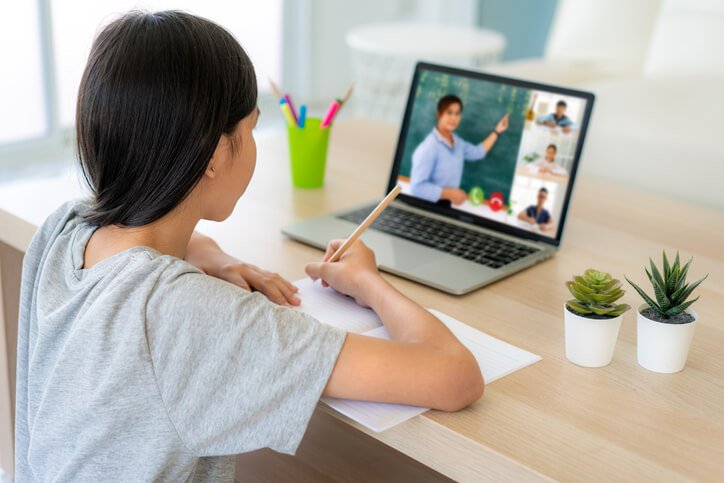How to Teach Online: Strategies, Tips and Tools
Online teaching and remote learning are more important than ever today, as COVID-19 turned 2020 into a year of educational experimentation with plenty of bumps along the way. The necessary transition from familiar physical classrooms to virtual versions is incredibly challenging for teachers, students and parents alike.
The U.S. Census Bureau notes that nearly 93% of households with school-age children reported some form of distance learning during the COVID-19 pandemic.
The good news: Teachers everywhere are using their creativity, talents and new technology to find new ways to do what they do best — teach their students. They are also, both individually and throughout the education community, teaching themselves how to teach online while learning and sharing successful online teaching strategies and best practices.
The ongoing need to continue this important learning curve is why we put together this guide to teaching online. Read on for strategies, tips and insights about:
- Getting organized
- Adapting to online teaching platforms
- Creating a supportive online classroom environment
- Online teaching tools and strategies
- The importance of creating student touchpoints
- Providing ongoing feedback
- Educational opportunities for teachers
Want the Brochure for USD’s Online Master of Education Degree?
Earn your M.Ed. in just 20 months with a program designed for working professionals.
Getting Organized
Getting organized to succeed at online teaching starts with understanding your school or district’s learning management system (LMS) as well as its procedures and protocols. From there, teachers are encouraged to develop a detailed plan for how they will tackle all of the basics, including:
- Creating new lessons and adapting existing ones to the virtual environment
- Connecting with and engaging their students
- Assigning, receiving and grading students’ work
- Communicating important information to both students and parents
- How to assess students’ understanding of the material
Leading a well-organized class is important for the students, their parents (who typically need to make scheduling adjustments and in some cases become more directly involved in keeping kids focused on school), as well as for teachers.
And, as you may have guessed, simplicity is key. In fact, ReadTheory.org offers some tips for this under the heading K.I.S.(f)S. — or “Keep It Simple (for the) Students.”
Online Teaching Platforms
Your school or district likely uses one of the leading online teaching and learning platforms, so it’s important to do your homework to fully understand its capabilities and limitations.
Some of the leading platforms being used as the conduit to organize and deliver online education today include:
Google Classroom – Use of this free, online service doubled to more than 100 million students and teachers around the world during 2020. Fun fact: In March, Italy’s Minister of Education contacted Google seeking help to immediately move the country’s entire school system online.
Zoom Rooms – Immensely popular for all types of remote work and socializing, Zoom is being used by teachers for real-time contact with students, colleagues and the school community. (Advice for “Creating Your Online Classroom Environment” is shared by teachers Megan Allen and Casey Daigle in their Zoom Education “Playbook.”)
Microsoft Teams for Education – The tech giant describes this as “a digital hub that brings conversations, content, assignments and apps together in one place,” letting educators create collaborative classrooms and vibrant learning environments.
Blackboard – Blackboard Unite for K-12 “brings together a world-class digital learning platform and safe teacher-to-parent communication tools to build bridges between students, parents and educators.” It is also the LMS used by the University of San Diego for its online Master of Education degree program.
Of course, while technology is obviously essential and central to the job of teaching your students online, it is important to remember that the “people part” of the equation is just as important as the “technology part.”
Creating a Supportive Online Classroom Environment
“We’re all in this together” can be a message that helps build the shared sense of community that is important to successful online teaching efforts.
“Remote learning is a lot to take in all at once,” Khan Academy advises teachers in a blog post offering tips for remote teaching and learning. “Share your distance teaching and learning experience with students, and let them know it’s OK to struggle with a new tool or a new concept.”
Connecting with students and keeping their attention in the virtual classroom is more challenging than doing so in your physical classroom, where you can see all the students at once, “read the room,” and more easily make specific or general adjustments to keep things moving forward.
To keep kids engaged, education blog Albert.io shares tips on how to “level up your presentation skills,” including “show your face” — that is, consider using your face as the onscreen focal point rather than the content. They also suggest that teachers avoid overly scripted communication in favor of talking to the camera as you would to your students in the classroom.
Using your online learning platform to establish a digital “homeroom” where teachers can share key info and communicate with students and parents/guardians is a widely used strategy.
Other general tips include:
- Establish your presence right from the start.
- Set clear expectations, but also let students know that this is new for everybody.
- Be available (“high-touch is more important than high-tech”).
Online Teaching Strategies
Here is a select compilation of online education strategies from teacher Matthew Dicks, writing in Slate (“A Teacher’s Guide to Successful Online Learning”).
- Look into the camera. “This will give your students the feeling that you are making eye contact with them.”
- Treat online class like classroom class. During live video sessions, students should not be permitted to eat, “nor should they be using their phones or any other software or video game on their computer.”
- Stand up. “At least some of the time. Your energy will translate so much better than if you’re sitting. And if you’re energetic, your students are more likely to listen.”
- Schedule individual meetings. This teacher held weekly one-on-one meetings with students and parents and found them to be “critical to student success.” Sessions focused on reviewing the previous week’s performance, discussing any new challenges and setting expectations for the coming week; and were recorded and sent to parents if they could not attend.
- Have fun! Creating opportunities to be creative, silly or personal can inspire engagement. For example: show and tell activities, or asking kids to “arrive to a lesson wearing their ugliest shirt, a homemade hat or accompanied by their favorite stuffed animal.”
Here are some tips and strategies we shared in a previous USD Master of Education blog post: “Remote Teaching Resources for Navigating the COVID-19 Crisis.”
- Streamline your goals: Identify and focus on a few specific things that you want students to learn.
- Make your virtual classroom distraction-free: Noise and movement affect students’ ability to focus.
- Look for ways to engage your students: Go around “the classroom” and ask them specific questions about the material; connect their answers to a question for the next student.
- Give up on having students’ undivided attention: But that doesn’t mean you can’t “call on” a student who doesn’t appear to be engaged.
- Use “asynchronous communication” tools: In addition to live video sessions, online bulletin boards, chat channels and discussion groups can be used to keep students learning outside your virtual classroom time.
- Check in on how your students are feeling: Students may be experiencing fear, anxiety and information overload that can affect their ability to learn.
- Support struggling students: Students may struggle technologically as well as academically. It’s also important to understand that not everyone has equal access to technology.
- Create space for fun: Bonus points for finding ways to add laughter to your lessons.
- Invest in a decent headset: One that also has a microphone will enable you to more clearly hear and respond to your students.
- Take care of yourself: The stress can be overwhelming, so it’s important to be aware, know your limits, reach out for a calming conversation or connect with specific resources (see Emotional Support Resources for Teachers).
Are You An Educator Considering the M.Ed Path?
Read the top 11 reasons to earn your master of education degree.
Online Teaching Tools
The ongoing evolution of educational technology has accelerated in response to current events. Here are a few engaging and effective teaching tools, including some we spotlighted in our post on “10 Ways to Use Technology in the Classroom.”
- Flipgrid — Pose a question or prompt, and then have students respond to it with short videos. Its creators describe Flipgrid as “the leading video discussion platform for millions of pre-K to Ph.D. educators, students and families in 180+ countries.”
- Quizizz — This tool aims to make formative assessment more fun by enabling educators to easily create engaging quizzes or choose from millions prepared by teachers around the world.
- Prodigy — Described as “the most engaging math platform in the world,” Prodigy has created free, curriculum-aligned, grade 1-8 math games and activities that are used by over 20 million students, teachers and parents.
- ClassDojo – This fun, free service connects teachers, students and parents in virtual classroom communities. Students can showcase and share their learning by adding photos and videos to their own portfolios. (See video.)
Online teaching tools recommended by eLearning Industry include:
- Edmodo is an educational tool that connects teachers and students, and is assimilated into a social network.
- TED-Ed uses the TED Talks model to share inspiring video lessons. It’s mission: “To capture and amplify the voice of the world’s greatest teachers.” (To see how to utilize TED-Ed and even submit your own lessons, watch a brief video.)
For a broader look at the fascinating landscape of online teaching tools, check out “350+ Amazing Online Learning Resources” from We Are Teachers.
Create Student Touchpoints
One of the most challenging aspects of remote teaching and learning is that the physical separation makes it more difficult to have that personal connection that is shared between teachers and their students.
Teachers far and wide are using all of the communication tools available to help bridge that gap with students and parents, including prerecorded lessons, email, cellphones and landlines, and even “snail mail.” The most important thing is to look for creative ways to let your students know that you care about them.
Provide Ongoing Feedback
“Feedback is an essential component of all effective learning environments – including online,” eLearning Industry states in an article on online teaching. “As an online teacher, your feedback will help to create an eLearning experience that is informative, engaging, and motivational for the learner. Your feedback should be continuous during the eLearning process, with constructive feedback offered as soon as possible so that students can clearly identify which behaviors or skills need to be improved.”
For one teacher/blogger’s insights into the heightened importance of feedback in the online education experience, check out Matthew M. Johnson’s informative piece on “The Essential Role of Feedback in Distance Learning.”
Related reading: “Online Learning More Important Than Ever in the Face of COVID-19 Crisis”
Educational Opportunities for Teachers
Being thrust into a new teaching challenge can also be a time for reflection on your own educational journey.
For example, do you have all the skills you need to teach effectively online? Are there areas of interest or a specialty that you would like to explore further, such as school leadership, digital learning or curriculum and instruction? Could immersing yourself in a proven effective online learning environment — as a student — potentially yield valuable experience and insights related to your role as a teacher?
Amid the monumental upheaval in education caused by the pandemic, the University of San Diego’s School of Leadership and Education Sciences is focused on making its online Master of Education degree program as valuable and immediately relevant as possible for teachers navigating the pivot to online teaching.
Best of all, for those who are already teaching online, our MEd program enables you to dive deeper into the online education experience with a unique opportunity to earn your master’s in 20 months while spending 15-20 hours per week on your studies. USD advisors are always available and eager to answer your questions and speak with you about how the online MEd program may align with your personal and professional educational goals.





